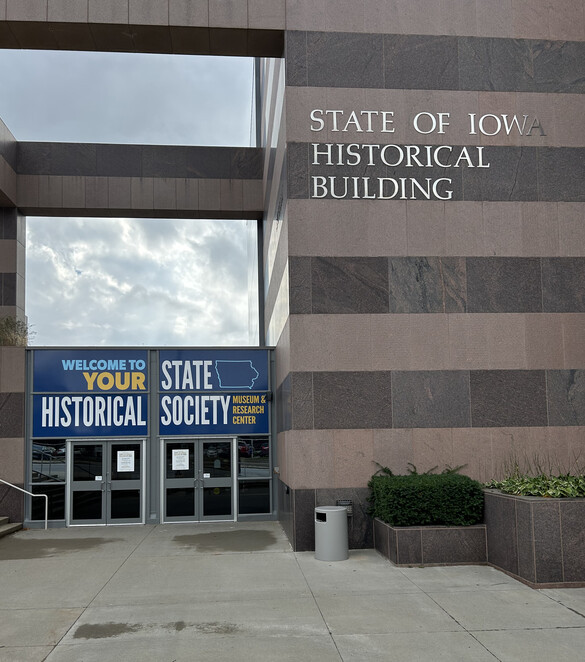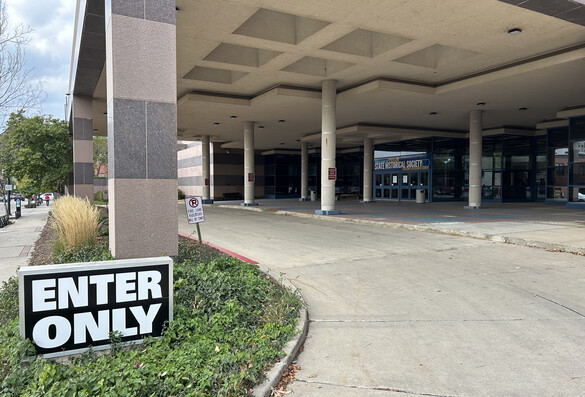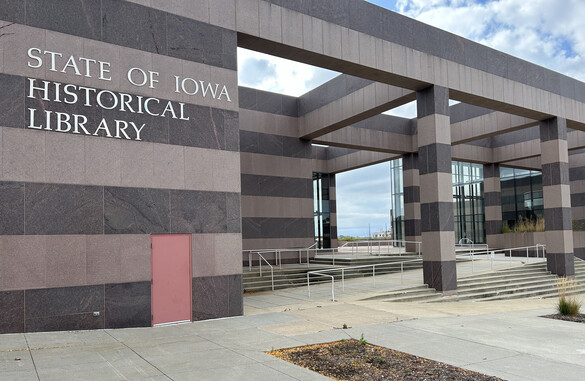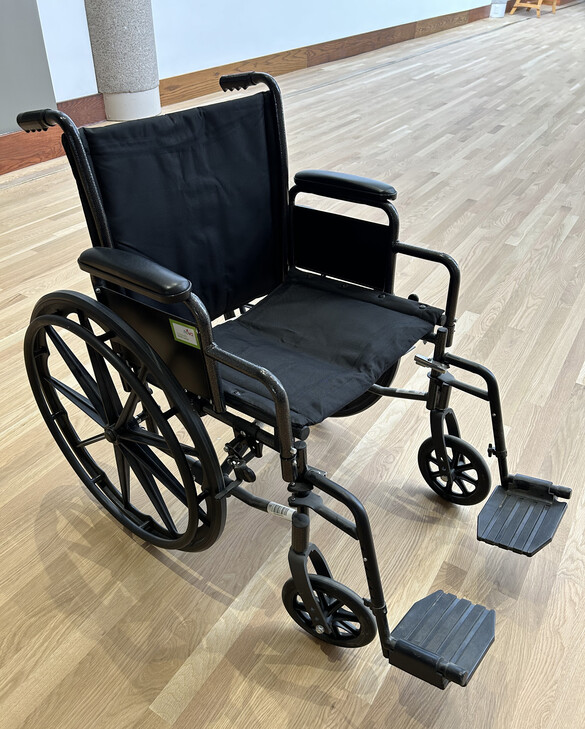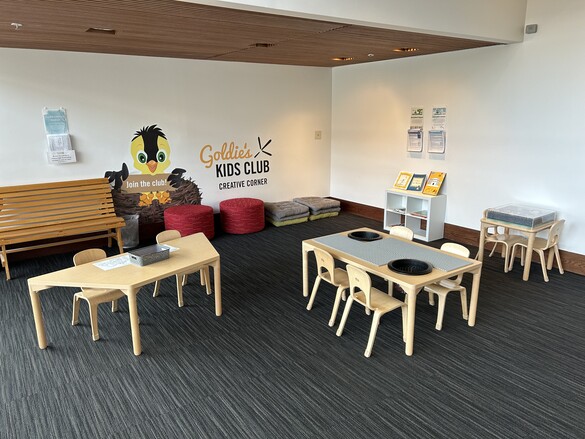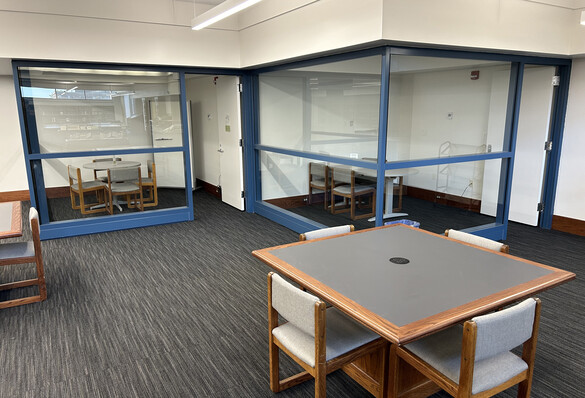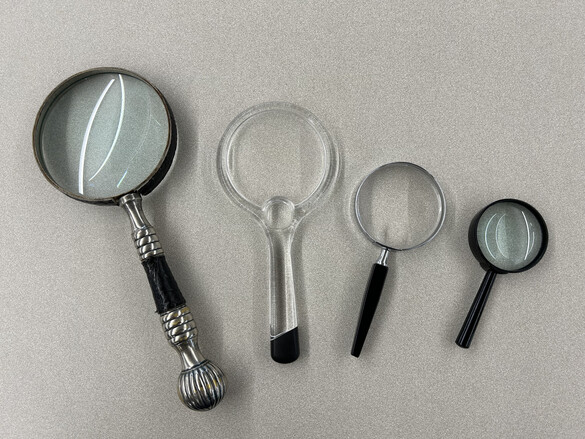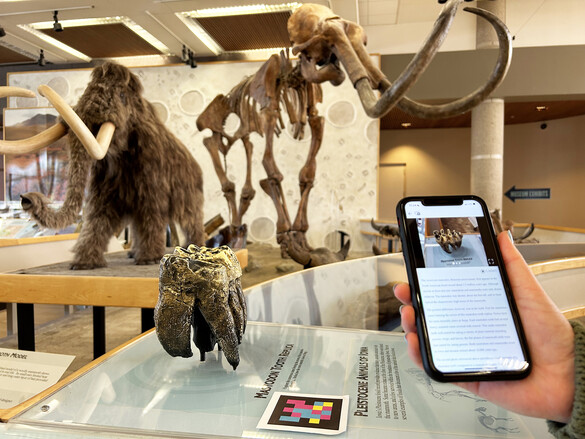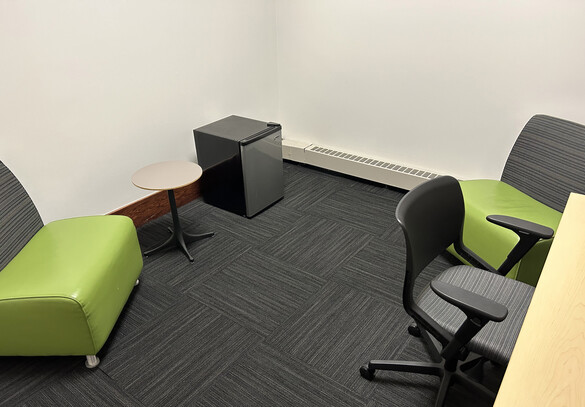On this page...
Updated 9/23/2025
Back to topArrival
Parking
Free parking is available in the parking garage at 650 Grand Avenue at the northwest corner of East Grand and Pennsylvania Avenue. All levels have accessible parking spots at the southeast corner of the garage. There are 18 accessible parking stalls—16 standard spaces and 2 van accessible spaces (both on Level A). Please note the van accessible spaces do not meet ADA width requirements. An elevator is located in the southeast stairwell.
Metered street parking is also available around the building and is payable via the ParkDSM ParkMobile app or at one of the nearby kiosks. One accessible metered parking space is located on the south side of Locust Street, across the street from the building entrance, and is indicated by a blue stall marker (#220607). Please note the driver’s side opens into the street. The meter costs $1.25/hr Monday–Saturday from 9:00 a.m.–9:00 p.m.
The portico driveway on Locust Street may be used as a drop-off area for passengers. Vehicles must be moved after drop off.
Public Transit
DART Paratransit is a door-to-door and wheelchair accessible service available for senior citizens and persons with disabilities who are unable to independently use DART’s Fixed Route bus service. Individuals who want to use Paratransit must fill out an application on the DART website. Paratransit riders must call ahead to reserve their trip.
Walkways & Entrances
All building entrances are accessible by ramp or stairs and have power-assist automatic door openers.
Grand Avenue Entrance
The closest entrance to the parking garage is on Grand Avenue where the building is labeled “State of Iowa Historical Building.” The doors are located under a sign that reads “Welcome to your State Historical Society Museum & Research Center.”
High resolution image of the State Historical Museum of Iowa entrance on Grand Avenue
Locust Street Entrance
The Locust entrance has power-assist automatic door openers, however the button in the vestibule does not work consistently when entering the building. If needed, please flag down staff at the information desk (visible from the entrance) or call 515-281-5111 for assistance.
Please note that the portico tiles may be slippery when wet. There is also a steep hill on Pennsylvania Avenue that goes downhill when traveling from Grand Avenue to Locust Street.
High resolution image of the State Historical Museum of Iowa entrance on Locust Street
Terrace Entrance
The Research Center is located on the second floor on the east side of the State Historical Building. There is a dedicated entrance on the terrace off of Grand Avenue where the building is labeled “Historical Library.”
If entering on the terrace, the Research Center will be straight ahead and the museum can be accessed by taking the elevator to the first floor.
High resolution image of the Research Center entrance doors on the terrace
High resolution image of the Research Center entrance on Grand Avenue
Back to topGeneral
First Aid
If you need emergency assistance, please dial 911.
A first aid kit is available at the information desk on the first floor of the museum. Museum and Research Center staff will help direct visitors in the event of an emergency.
Food & Drink
Vending machines are located on the first level of the museum near the east elevator. Various drinks and snacks are available for purchase using cash or credit card. The current vending menus are available online. Straws are available at the information desk upon request.
No designated lunch space is provided, but visitors are welcome to bring their own food and drinks, which can be consumed in the museum atrium or in the seating area outside of the Research Center. Please note no food or drinks are allowed in the exhibit galleries or Research Center.
Service Animals
Service animals specially trained to assist a person with a disability are welcome in all museum exhibits and public spaces. Pets, therapy animals, and emotional support animals are not considered service animals and are not allowed.
Nearest veterinary services:
All-Pets Hospital
Open Monday–Friday, 8:00 a.m.–5:30 p.m. and every other Saturday, 8:00 a.m.–1:00 p.m.
1 mile away; approx. 5-min drive
1330 2nd Avenue, Des Moines, IA 50314
515-262-8535
Mobility
Wheelchairs
The State Historical Building is mostly wheelchair accessible except where noted below.
Several exhibit spaces were developed in the 1980s and are not fully ADA-compliant. The Great Plains ADA Center conducted an ADA audit of the museum and reported that two ramps in Delicate Balance and two ramps in You Gotta Know the Territory are steeper than ADA recommendations. Museum staff are working on improving exhibit spaces.
Ambulatory stalls are located in each restroom, but please note there are unfortunately no wheelchair accessible stalls in the State Historical Building.
There are several tables at the Research Center that are wheelchair accessible, including all computer and scanner tables, and in the large Collaboration Space room. Please note some of the older tables in the space are not wheelchair accessible. Additionally, some library and archival materials may be difficult to reach or access. Please work with the Library and Archives Research Center staff to accommodate your needs on site, or call in advance at 515-281-6200.
High resolution image of a wheelchair available to borrow
A limited number of manual wheelchairs are available for visitors to use free of charge. The wheelchair has a 20” seat with a 325 lb. weight capacity. To request a wheelchair, please visit the information desk on the first floor.
Seating
A variety of seating is available in the museum atrium, exhibits and in the Research Center. Padded seating can be found in the Research Center during open hours and in the reading area of Hands-On History on the first floor of the museum.
Lockers
There are 36 lockers available for public use. They are located outside the Research Center on the second floor of the east side of the building. The lockers use any 4-digit code of the user's choosing. Lockers 2, 5 and 8 are wheelchair accessible and use keypads. Instructions are available on the wall next to the lockers.
High resolution image of accessible lockers with keypads
Elevators
An elevator located on the north side of the atrium is available to access all levels of the museum. Exhibits are located on the first and second floors. An elevator on the east side of the building provides first floor access to the museum and second floor access to the Research Center.
All elevators have tactile signs and braille. Thank you to the Iowa Department for the Blind for providing braille.
Restrooms
All restrooms feature the following unless otherwise noted:
- Tactile entrance sign, including raised letters and braille
- Power-assist automatic door opener
- Infant changing table except the Research Center restrooms, which do not have changing tables
- 7-inch stool located under the sink, which may also be used for the drinking fountains outside the restrooms
- Automatic paper towel dispensers and electric hand dryers. The hand dryers have labels that read: “Please use paper towels to be more accommodating to visitors with sensory sensitivities”
Ambulatory stalls are located in each restroom, but please note there are no wheelchair accessible stalls in the State Historical Building.
The building is also not equipped with adult changing tables. Should a visitor require an adult changing table, please connect with staff prior to your visit by emailing shsi.accessibility@iowa.gov or calling 515-281-8352.
Water Fountains
Wheelchair accessible water fountains are located near all museum restrooms. Wheelchair accessible water fountains are also located near the elevator outside of the Research Center on the second floor. Please feel free to use the bathroom stools for the drinking fountains. Please note the water fountains protrude into the circulation path and are not cane-detectable.
Exhibits
Several exhibit spaces were developed in the 1980s and are not fully ADA-compliant. The Great Plains ADA Center conducted an ADA audit of the museum and reported that two ramps in Delicate Balance and one ramp in You Gotta Know the Territory are steeper than ADA recommendations. Museum staff are working on improving exhibit spaces.
Please also note that visitors will encounter lower light levels in some of the exhibit galleries. For additional sensory information, please see the Sensory Details section below.
Auditorium
The auditorium seats up to 246 people and is physically accessible with six ADA-compliant spots with companion seats. Accessible seating is located in the front and back of the auditorium. An elevator and wheelchair ramp is available for seating at the front of the auditorium and for stage access.
Classrooms
The State Historical Museum offers three classroom spaces to host community events—Goldfinch and Geode on the first floor, and Wild Rose on the third floor. The classrooms do not have automatic door openers.
Back to topSensory Sensitivities
Times to Visit
Mornings between 9:00 – 10:00 a.m. are usually less busy, quieter times of the day to visit. The winter months are also typically quieter. Visitation will vary depending on holidays, school vacations, weather and other factors. Please call the information desk at 515-281-5111 to inquire about days with no scheduled group visits.
The Research Center is consistently quiet during open hours. If you schedule an appointment in advance, the reference librarian will let you know if there is a scheduled group visit. Earplugs are also available at the Research Center information desk and headphones are allowed.
Preview the Galleries
It may be helpful to review the Museum Exhibit Guide and to explore the online exhibits to prepare for your visit. The following exhibits are currently available to view online:
Sensory Details
Lighting
- When standing at certain angles, some museum lighting reflects off of tall exhibit cases and plastic-protected artifacts displayed higher up, most notably in the exhibit Visible Vault.
- A looping video by Tiny Circus in the Riding Through History exhibit (located at the exit to You Gotta Know the Territory) was created using stop motion and the flickering light may cause a strobe effect during some parts of the video.
- The atrium can be very bright with natural sunlight when exiting the dimly-lit galleries.
Sound
- The HVAC system hums throughout the atrium and galleries.
- Most exhibits have auto-play videos and/or sound bleeds that can be heard throughout the galleries. Many videos have a countdown timer to indicate when they will begin, but other sounds will play without warning.
- Delicate Balance on the first floor loops quiet nature sounds throughout the galleries, including flowing water and honking geese.
- You Gotta Know the Territory loops gentle flute music throughout the Native American section of the exhibit.
- The Hollywood in the Heartland and Riding Through History exhibits on the second floor feature multiple videos with competing sounds in the space.
Other
- All galleries are typically cool in temperature and the atrium is warmer. The auditorium is also often cold.
- There are two unmarked ramps in Delicate Balance and three unmarked ramps in You Gotta Know the Territory. There is also a domed bark lodge replica in You Gotta Know the Territory where there are small, unmarked inclines to enter on either side and the overhangs above both sides are lower than 6 feet high.
Quiet Spaces
There are currently no designated quiet spaces. Two areas—Hands-On History on the first floor and the Goldie’s Kids Club Creative Corner on the second floor—both have comfortable areas with a variety of seating options. These spaces can be relatively quiet with minimal to no sound bleed depending on other visitors. These spaces are also great activity areas with room for movement and play. Please inquire at the museum information desk if you may need access to a quiet space during your visit and we will do our best to accommodate.
High resolution image of the Hands-On History reading corner
High resolution image of the Goldie's Kids Club Creative Corner
The Collaboration Spaces in the Research Center may be used as designated quiet spaces and are available during Research Center open hours Wednesday–Saturday. There is one large room and one small room, both with tables that seat four people. Please note they have glass walls, as pictured below. Archival material is not allowed in the Collaboration Spaces for collection safety, however visitors may use the space to read books in the library collection.
High resolution image of the Collaboration Spaces in the Research Center
Headphone Zones
Second floor exhibits Hollywood in the Heartland and Riding Through History are designated as Headphone Zones. In these galleries, decibel readings register higher than 70 dB on average.
Visitors with sound sensitivities may want to use noise-canceling headphones or ear defenders in these exhibits. A limited number of noise-canceling headphones and ear defenders are available to borrow on a first-come, first-served basis. Visitors are required to leave a photo ID with information desk staff when borrowing headphones. Disposable earplugs are also available.
Back to topDeaf or Hard of Hearing
Most videos in the galleries are transcribed or captioned. Museum staff are working to add open captions to the remaining videos.
A limited number of iPads are available to borrow on a first-come, first-served basis at the information desk on the first floor. The iPads have several accessibility apps enabled, including Otter which can be used to transcribe spoken conversations and caption video. Please see the Alternative Exhibit Text Formats section for more information.
Automatic closed captioning is available for all online programs. To request live captioning or ASL interpretation for an online or in-person event, please email shsi.accessibility@iowa.gov or call 515-281-8352 at least two weeks in advance if possible.
Back to topBlind or Low Vision
Visitors will encounter lower light levels in some of the exhibit spaces. There are also several unmarked changes in flooring levels in the exhibits Delicate Balance and You Gotta Know the Territory. For assistance through the galleries, please inquire at the museum information desk or call 515-281-5111.
Please also note the water fountains near the restrooms protrude into the circulation path and are not cane-detectable.
NaviLens Navigation Technology
Try out an exciting new way to experience the State Historical Museum of Iowa! Using the free smartphone app called NaviLens, visitors can scan a room to hear what is located in that direction and its proximity. The app can direct visitors to exits, restrooms, elevators, exhibits, and more. Visitors also gain access to artifact descriptions, locations of touchable objects, and exhibit content—all read out loud from your personal device.
Learn more about NaviLens in the Alternative Exhibit Text Formats section.
Large Print
Magnifying sheets for enlarging exhibit text are available at the information desk on the first floor of the museum. At the Research Center, magnifying glasses of various sizes are available for enlarging text (pictured below) and all microfilm readers can enlarge microfilm.
High resolution image of the magnifying glasses available to borrow
A limited number of iPads are also available to borrow on a first-come, first-served basis at the information desk on the first floor. The iPads have several accessibility apps enabled, including Seeing AI and Be My Eyes, which can assist visitors by reading text aloud, describing images, and navigating spaces. Please see the Alternative Exhibit Text Formats section for more information.
Online exhibit text can also be enlarged for large print and read by a screen reader. Please see the Online Exhibit Text section for more information.
Braille
Iowa’s People & Places exhibit text is available in braille upon request at the information desk. Thank you to the Iowa Department for the Blind Braille Group for this transcription.
Touch Tours
Exhibit touch tours are available upon request with at least three weeks' advance notice. These tours are one hour in length and include opportunities to touch various artifacts. If you are interested in requesting a touch tour, please email shsi.accessibility@iowa.gov or call 515-281-8352.
Screen Readers
Please see the Alternative Exhibit Text Formats section for accessible exhibit text.
Back to topAlternative Exhibit Text Formats
NaviLens
High resolution image of Navilens in the exhibit Mammoth: Witness to Change
NaviLens is an exciting new way to experience the State Historical Museum of Iowa! Using the free smartphone app NaviLens GO, visitors can scan an exhibit space to pick up innovative digital codes that unlock never-before-seen exhibit content including images, videos, audio, and language translations. Select “Content for kids” in the app settings to access scavenger hunts, Goldie’s Tweets, and fun ways for kids to engage with exhibits.
A separate free app called NaviLens (without the “GO”) provides additional navigation information for people who are blind or have low vision, alerting visitors to exits, restrooms, elevators, exhibits, and more. Scan a room with the app to hear what is located in that direction and its proximity. Visitors also gain access to artifact descriptions, locations of touchable objects, and exhibit content—all read out loud from your personal device.
Best of all the apps are free to download and don't require an account—all a visitor needs is a smart device. No smartphone? No problem! A limited number of iPads are available to borrow from the museum information desk.
NaviLens was made possible with the support of a Prairie Meadows Community Betterment Grant.
Accessibility Apps
A limited number of iPads are available on a first-come, first-served basis at the information desk on the first floor. Visitors are required to leave a photo ID with information desk staff when borrowing an iPad.
The iPads have standard, built-in accessibility features, including VoiceOver and Magnifier, and have the ability to invert colors, convert to grayscale, increase contrast and more. They also have the following accessibility apps enabled:
- Seeing AI (iOS or Android) and Google Lookout (Android only) both read text out loud and can describe images and surroundings using a smart device’s camera.
- Be My Eyes (iOS or Android) leverages artificial intelligence to describe images and scenes. Users can also call a volunteer who can “see” through the device’s camera lens and give real-time assistance.
- Google Lens (iOS or Android) can use an image or a device’s camera to search online without the need to type or describe in words.
- Otter (iOS or Android) transcribes live speech during a conversation and can automatically caption videos or other audio content.
- DeepL (iOS or Android) can translate up to 30 languages in real time from text, image or voice.
- Google Translate (iOS or Android) can translate up to 133 languages from text, image or voice.
Visitors are also encouraged to download and explore these free accessibility apps on their own smart devices before visiting the museum. If needed, the WiFi password can be requested at the museum’s information desk on the first floor.
Online Exhibit Text
Online exhibit text can be copied and pasted, enlarged for large print, read by a screen reader, and fonts and colors can be altered using accessibility extensions on your browser. W3C Web Accessibility Initiative offers guidance on how to change text size or colors.
Text is currently available online for the following exhibits:
Museum staff are working to provide more online exhibit text.
Back to topLimited English Proficiency
Spanish Exhibit Text
El texto de la exhibición Gente y Lugares de Iowa (Iowa’s People & Places) está disponible en español en línea o a pedido.
A Spanish language translation is currently available for the Iowa’s People & Places exhibit. The Spanish translation can be accessed online or can be requested in print at the information desk.
Translation Technology
- iPad Apps: A limited number of iPads are available to borrow on a first-come, first-served basis at the information desk on the first floor. The iPads have several translation apps enabled, including DeepL and Google Translate, which can assist visitors by translating English into multiple languages via text, image or voice. Please see the Alternative Exhibit Text Formats section for more information.
- NaviLens: Using the free smartphone app called NaviLens GO, visitors can scan an exhibit space to pick up innovative digital codes that unlock never-before-seen exhibit content including images, videos, audio, and language translations. Select from 36 different languages in the app settings to automatically translate the content into your preferred language. Learn more about NaviLens in the Alternative Exhibit Text Formats section.
Translated Tours
Exhibit tours with a translator must be requested at least three weeks in advance and are subject to staff availability. Please provide your own translator or museum staff can help connect you with translators in the area. Email shsi.accessibility@iowa.gov or call 515-281-8352 to inquire about a translated tour.
Back to topFamilies with Young Children
Strollers & Wagons
Strollers and wagons are allowed in all public areas of the museum.
Restrooms
There are four restrooms in the museum. Three are available at the northwest corner, one on each of the three levels. The fourth is available on the first floor on the east side of the atrium. An infant changing table is located in each restroom and 7-inch stools are available for child handwashing. Please feel free to use the bathroom stools for the drinking fountains as well.
Restrooms are also located outside of the Research Center on the second floor of the east side of the building. Please note there are no infant changing tables available in the Research Center restrooms.
Nursing Room
A private space for nursing is currently not available to the public. Please inquire at the information desk for potential access to the employee’s nursing room on the third floor. The room has a lock, a window screen for privacy, and a small fridge. Please note that this space is for individual use. A sink can be accessed in the employee break room just around the corner or in the public restroom. We plan to provide a private nursing room for public use in the future.
High resolution image of the nursing room
Youth Activities
The following educational materials and activities are available for self-guided visits at the museum and are geared toward the indicated age groups or grades.
- NaviLens (3rd–8th grade, but may be adapted for younger audiences)
- Using the free smartphone app NaviLens GO, visitors can scan an exhibit space to pick up innovative digital codes that unlock never-before-seen exhibit content including images, videos, audio, and language translations. Select “Content for kids” in the app settings to access scavenger hunts, Goldie’s Tweets, and fun ways for kids to engage with exhibits. Learn more about NaviLens in the Alternative Exhibit Text Formats section.
- Hands-On History (10 and younger)
- Goldie’s Object Search (Preschool–2nd grade, but may be adapted for younger audiences)
- Goldie’s Tweets (3rd–8th grade)
- Activity Book (ages 8–12, but may be adapted for younger audiences)
- Request a printed copy at the information desk or pick one up in Hands-On History on the first floor
- Museum Exhibit Guide (9th–12th grade and adults)
- Request a printed copy at the information desk
Find more information about youth and family programs and Goldie’s Kids Club on the website. Read the State Historical Museum of Iowa Visit Expectations for students, teachers, and chaperones to prepare for a visit with children.
Back to topOther Accommodations & Feedback
The State Historical Society of Iowa (SHSI) is committed to providing accessible and welcoming experiences for all audiences. Our accessibility work is led by a 12-member Accessibility Advisory Group made up of volunteers dedicated to making Iowa history more accessible:
- Kelsey Burr
- Bettina Dolinsek, Ankeny
- Cody Dolinsek, Ankeny
- Erin Enyart, Ankeny
- Robert Fisher, Adel
- Tiffany Hoffman, Ankeny
- Ryn Jahn, Ames
- Brooke Lovelace, Newton
- Adam Reynolds, Des Moines
- Daniel Van Sant, Des Moines
- Meri Vanahn
- Sarah Young Bear-Brown, Meskwaki Settlement (Tama)
Under the advisory group's guidance, SHSI staff continue to make improvements to the State Historical Building and receive ongoing disability etiquette training and information.
We welcome feedback about the accessibility of SHSI spaces and the accommodations available. Please fill out this short survey online to provide feedback about your visit or ask staff how you can take the survey during your visit.
For accessibility questions and to request reasonable accommodations, please contact Accessibility Coordinator Lindsay Keast at shsi.accessibility@iowa.gov or call 515-281-8352. Please note that at times, certain accommodations may not be possible.
Back to top